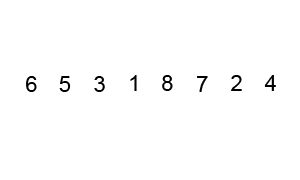-
Preface
- FAQ
-
Part I - Basics
- Basics Data Structure
- Basics Sorting
- Basics Algorithm
- Basics Misc
-
Part II - Coding
- String
-
Integer Array
-
Remove Element
-
Zero Sum Subarray
-
Subarray Sum K
-
Subarray Sum Closest
-
Recover Rotated Sorted Array
-
Product of Array Exclude Itself
-
Partition Array
-
First Missing Positive
-
2 Sum
-
3 Sum
-
3 Sum Closest
-
Remove Duplicates from Sorted Array
-
Remove Duplicates from Sorted Array II
-
Merge Sorted Array
-
Merge Sorted Array II
-
Median
-
Partition Array by Odd and Even
-
Kth Largest Element
-
Remove Element
-
Binary Search
-
First Position of Target
-
Search Insert Position
-
Search for a Range
-
First Bad Version
-
Search a 2D Matrix
-
Search a 2D Matrix II
-
Find Peak Element
-
Search in Rotated Sorted Array
-
Search in Rotated Sorted Array II
-
Find Minimum in Rotated Sorted Array
-
Find Minimum in Rotated Sorted Array II
-
Median of two Sorted Arrays
-
Sqrt x
-
Wood Cut
-
First Position of Target
-
Math and Bit Manipulation
-
Single Number
-
Single Number II
-
Single Number III
-
O1 Check Power of 2
-
Convert Integer A to Integer B
-
Factorial Trailing Zeroes
-
Unique Binary Search Trees
-
Update Bits
-
Fast Power
-
Hash Function
-
Happy Number
-
Count 1 in Binary
-
Fibonacci
-
A plus B Problem
-
Print Numbers by Recursion
-
Majority Number
-
Majority Number II
-
Majority Number III
-
Digit Counts
-
Ugly Number
-
Plus One
-
Palindrome Number
-
Task Scheduler
-
Single Number
-
Linked List
-
Remove Duplicates from Sorted List
-
Remove Duplicates from Sorted List II
-
Remove Duplicates from Unsorted List
-
Partition List
-
Add Two Numbers
-
Two Lists Sum Advanced
-
Remove Nth Node From End of List
-
Linked List Cycle
-
Linked List Cycle II
-
Reverse Linked List
-
Reverse Linked List II
-
Merge Two Sorted Lists
-
Merge k Sorted Lists
-
Reorder List
-
Copy List with Random Pointer
-
Sort List
-
Insertion Sort List
-
Palindrome Linked List
-
LRU Cache
-
Rotate List
-
Swap Nodes in Pairs
-
Remove Linked List Elements
-
Remove Duplicates from Sorted List
-
Binary Tree
-
Binary Tree Preorder Traversal
-
Binary Tree Inorder Traversal
-
Binary Tree Postorder Traversal
-
Binary Tree Level Order Traversal
-
Binary Tree Level Order Traversal II
-
Maximum Depth of Binary Tree
-
Balanced Binary Tree
-
Binary Tree Maximum Path Sum
-
Lowest Common Ancestor
-
Invert Binary Tree
-
Diameter of a Binary Tree
-
Construct Binary Tree from Preorder and Inorder Traversal
-
Construct Binary Tree from Inorder and Postorder Traversal
-
Subtree
-
Binary Tree Zigzag Level Order Traversal
-
Binary Tree Serialization
-
Binary Tree Preorder Traversal
- Binary Search Tree
- Exhaustive Search
-
Dynamic Programming
-
Triangle
-
Backpack
-
Backpack II
-
Minimum Path Sum
-
Unique Paths
-
Unique Paths II
-
Climbing Stairs
-
Jump Game
-
Word Break
-
Longest Increasing Subsequence
-
Palindrome Partitioning II
-
Longest Common Subsequence
-
Edit Distance
-
Jump Game II
-
Best Time to Buy and Sell Stock
-
Best Time to Buy and Sell Stock II
-
Best Time to Buy and Sell Stock III
-
Best Time to Buy and Sell Stock IV
-
Distinct Subsequences
-
Interleaving String
-
Maximum Subarray
-
Maximum Subarray II
-
Longest Increasing Continuous subsequence
-
Longest Increasing Continuous subsequence II
-
Maximal Square
-
Triangle
- Graph
- Data Structure
- Big Data
- Problem Misc
-
Part III - Contest
- Google APAC
- Microsoft
- Appendix I Interview and Resume
-
Tags
Bubble Sort - 冒泡排序
核心:冒泡,持续比较相邻元素,大的挪到后面,因此大的会逐步往后挪,故称之为冒泡。

Implementation
Python
#!/usr/bin/env python
def bubbleSort(alist):
for i in xrange(len(alist)):
print(alist)
for j in xrange(1, len(alist) - i):
if alist[j - 1] > alist[j]:
alist[j - 1], alist[j] = alist[j], alist[j - 1]
return alist
unsorted_list = [6, 5, 3, 1, 8, 7, 2, 4]
print(bubbleSort(unsorted_list))
 copy
copyJava
public class Sort {
public static void main(String[] args) {
int[] unsortedArray = new int[]{6, 5, 3, 1, 8, 7, 2, 4};
bubbleSort(unsortedArray);
System.out.println("After sort: ");
for (int item : unsortedArray) {
System.out.print(item + " ");
}
}
public static void bubbleSort(int[] nums) {
int len = nums.length;
for (int i = 0; i < len; i++) {
for (int num : nums) {
System.out.print(num + " ");
}
System.out.println();
for (int j = 1; j < len - i; j++) {
if (nums[j - 1] > nums[j]) {
int temp = nums[j - 1];
nums[j - 1] = nums[j];
nums[j] = temp;
}
}
}
}
}
 copy
copy复杂度分析
平均情况与最坏情况均为 , 使用了 temp 作为临时交换变量,空间复杂度为 .
